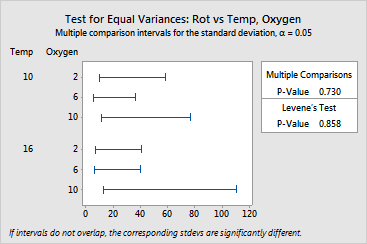main topic interpreting results session command see also
You study conditions conducive to potato rot by injecting potatoes with bacteria that cause rotting and subjecting them to different temperature and oxygen regimes. You use Test for Equal Variances to test whether the variability in the amount of rot is affected by the changes in temperature and oxygen.
1 Open the worksheet EXH_AOV.MTW.
2 Choose Stat > ANOVA > Test for Equal Variances.
3 Choose Response data are in one column for all factor levels.
4 In Response, enter Rot.
5 In Factors, enter Temp Oxygen. Click OK.
Session window output
Test for Equal Variances: Rot versus Temp, Oxygen
Method
Null hypothesis All variances are equal Alternative hypothesis At least one variance is different Significance level α = 0.05
95% Bonferroni Confidence Intervals for Standard Deviations
Temp Oxygen N StDev CI 10 2 3 5.29150 (0.0011705, 198381) 10 6 3 3.00000 (0.0006636, 112472) 10 10 3 6.55744 (0.0014506, 245842) 16 2 3 3.60555 (0.0007976, 135174) 16 6 3 3.51188 (0.0007769, 131663) 16 10 3 8.32666 (0.0018419, 312171)
Individual confidence level = 99.1667%
Tests
Test Method Statistic P-Value Multiple comparisons — 0.730 Levene 0.37 0.858 |
Graph window output

The p-value for the multiple comparisons test is significant only if two or more intervals do not overlap.
The summary plot displays the multiple comparison intervals. If the intervals for two groups do not overlap, then the standard deviations for those groups are significantly different.
The Session window displays the Bonferroni simultaneous confidence intervals for the standard deviations of each population.
Both the summary plot and the Session window display the p-values for the multiple comparisons test and Levene's test. In general, you should base your conclusions on the multiple comparisons method, unless you have small samples from very skewed, or heavy-tailed distributions. (See Tests of equal variance for further discussion.)
For the potato rot example, the p-values of 0.730 and 0.858 are greater than reasonable choices of a, so you fail to reject the null hypothesis that the variances are equal. However, with only 3 observations in each group, the tests do not have much power to detect a difference if one does exist. You should consider collecting more data to increase the power of the test.